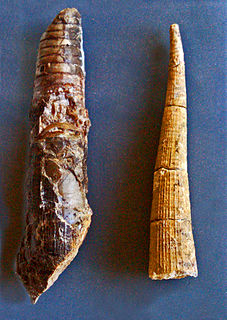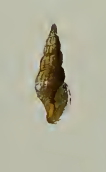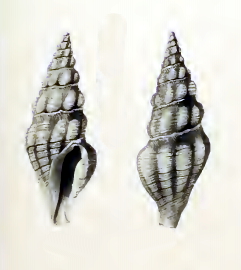Related Research Articles
Atsabites is an ammonoid cephalopod belonging to the ceratitid family Atsabitidae that lived during the Middle Permian between about 294 and 284 million years ago.
Yinoceras is a genus of middle Permian goniatitid ammonite, the type genus for the subfamily Yinoceratinae of the family Pseudohaloritidae.
Uraloceras is an ammonoid cephalopod genus belonging to the goniatitid family Paragastrioceratidae. The genus was named by Ruzhencev 1936 and is a jr. synonym of Pseudogastrioceras Spath 1930 according to Miller, Furnish and Schindeworlf, 1957. More recent classifications however list the two as distinct genera and put Uraloceras in the Paragastrioceratinae and Pseudogastrioceras in the Pseudogastrioceratinae.

Kionoceras is an extinct nautiloid cephalopod genus included in the orthocerid family Kionoceratidae with scattered worldwide distribution from the Middle Ordovician to the Lower Permian. Kionoceratids are orthocerids with prominent longitudinal ornamentation on their shells, sometimes augmented by secondary transverse ornamenttion. Orthocerids are, of course, prehistoric nautiloides with generally straight and elongate shells, mostly with central or subcentral siphuncles.
The Trigonoceratidae is a family of coiled nautiloid cephalopods that lived during the period from the Early Carboniferous (Mississippian) to the Early Permian.

Asperdaphne elegantissima is a species of sea snail, a marine gastropod mollusk in the family Raphitomidae.

Asperdaphne subzonata is a species of sea snail, a marine gastropod mollusk in the family Raphitomidae.

Brachytoma rioensis is a species of sea snail, a marine gastropod mollusk in the family Pseudomelatomidae.

Brachytoma rufolineata is a species of sea snail, a marine gastropod mollusk in the family Pseudomelatomidae.
Neoaganides is a small, 1–2 cm diameter subdiscoidal to subglobular goniatitid belonging to the family Pseudohaloritidae that lived from the Late Pennsylvanian to the Late Permian, existing for some 56 million years.
Doulingoceras is a genus of ammonoid within the ceratitid order, found in China,that lived during the Late Permian during the time span from about 260.5 to 254 million years ago. The genus is included in the family Paraceltitidae, which belongs to the superfamily Xenodiscaceae.
Lyrogoniatitites is a neoglyphiocercean ammonite, in the order Goniatitida, related to genera like Alaoceras, Cravenoceras, Dumbarigloria and Pachylyroceras.
Cravevoceras is an Upper Paleozoic ammonite in the gonititid family Cravenoceratidae, probably derived from Pachylyroceras and contemporary with other cravenoceratid genera like Caenolyroceras, Tympanoceras and later Alaoceras and Lyrogoniatites. It is also a member of the Neoglyphiocerataceae.
Inyoites is an ammonoid genus from the Lower Triassic, included in the ceratitid family Inyoitidae.

Ophiceras is a genus of smooth, evolute ceratitid ammonites from the Lower Triassic, with a rounded venter.
Branneroceras is a goniatitid genus from the Late Carboniferous. Their fossils have been found in Nunavut, Canada, and in Arkansas and Texas, USA.
Gastrioceras is a goniatitid genus in the family Gastrioceratidae that lived during the late Carboniferous (Pennsylvanian and for most of the Permian.
Drillia fijiensis is a species of sea snail, a marine gastropod mollusc in the family Drilliidae.

Heterocithara himerta is a species of sea snail, a marine gastropod mollusk in the family Mangeliidae.
References
- Frest, T.J, B.F Glenister and W.M Furnish; 1981. Pennsylvanian-Permian Cheiloceratacean Ammonoid Families Maximitidae and Pseudohaloritidae. Memoir 11, the Paleontological Society; Jour Paleo V. 55, May 1981, supplement.
- Zhao, J. K. and Zheng, Z. G.. 1977. The Permian ammonoids from Zhejiang and Jiangxi. Acta Palaeontologica Sinica 16:217-252.
- Shouchangoceras in Paleobiology db.
| This Goniatite-related article is a stub. You can help Wikipedia by expanding it. |